Worth-while ...
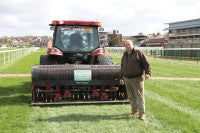 Worth Draining was set up in 1984 by Peter Bloodworth, who saw an opportunity to provide specialist contract work to golf courses and sports clubs. At the time, Peter was chairman of Stoke Rochester Golf Club, and was made aware of the new developments in aeration machinery by Jim Arthur, renowned golf course agronomist, who had come across a new concept in deep aeration - the Verti-Drain.
Worth Draining was set up in 1984 by Peter Bloodworth, who saw an opportunity to provide specialist contract work to golf courses and sports clubs. At the time, Peter was chairman of Stoke Rochester Golf Club, and was made aware of the new developments in aeration machinery by Jim Arthur, renowned golf course agronomist, who had come across a new concept in deep aeration - the Verti-Drain.
The Verti-Drain revolutionised turfcare, not only by penetrating deeper, but also by its manner of operation; the tines 'heave' the soil as they leave the ground, shattering deep-rooted compaction. This creates extra pore and air space, which encourages drainage, healthy grass growth and beneficial microbial activity. Over the past quarter century, a complete range of Verti-Drains, and their clones, have been developed, including pedestrian and tractor-towed versions, for turfcare professionals managing all kinds of facilities.
Worth Draining bought one of the very early production models, a Verti-Drain 105145 (1.5m wide), which they used to decompact golf greens, football pitches and other playing surfaces.
As with any new machinery, it was a case of trying it out and learning from experience. And they had plenty of that - quite often they would find the machine 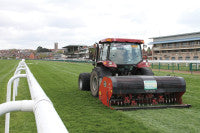 bringing up large chunks of turf, and even large stones. They soon realised that working with the weather, and having a better understanding of the construction and management of the site, helped enormously.
bringing up large chunks of turf, and even large stones. They soon realised that working with the weather, and having a better understanding of the construction and management of the site, helped enormously.
They were also able to work closely with the manufacturers, Redexim Charterhouse, to rectify any problems and issues. Plenty of modifications were made, which led to new models being designed and built.
Paul Simpson, Worth Draining's contracts manager, who has been with the company since 1987, has played an important part in helping develop and improve the Verti-Drain, and has, himself, overseen some modifications to the company's own Verti-Drain fleet to help them perform more smoothly.
Paul remembers the first time the machine was tried out on a cricket table back in the mid 1980s, under the guidance of the then Oakham School Head Groundsman, Keith Exton, who wanted to experiment with the new technology - a brave decision, but one he has persevered with until this day. Keith, now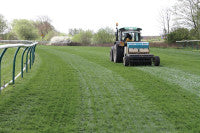 Head Groundsman at Glamorgan CCC, has perfected the use of deep solid tine machines to help him produce better quality cricket tables.
Head Groundsman at Glamorgan CCC, has perfected the use of deep solid tine machines to help him produce better quality cricket tables.
Over the years, the company has built up a good reputation for providing specialist services; they have a large fleet of equipment to cope with a wide range of renovation works on golf courses, winter sports pitches (football/rugby) and racecourses. "The company's reputation is only as good as your last job," says Paul Mason. "It takes time to build up a dedicated team of staff who are prepared to work long hours, something that is par for the course in contracting."
The company have just four full time staff; Paul Atkinson, Phil Baxter, Phil Taylor and Paul himself.
"It is always nice to get regular and repeat business," says Paul. "Not only does it help us to plan and manage our resources more efficiently, but is an endorsement of the quality of our work, After all, there's plenty of competition out there, should we ever get it wrong."
"Most of our work is centred on renovation programmes on golf courses and racecourses; we currently look after over twenty race courses, including Leicester, Warwick, Yarmouth, Huntington, Doncaster and Hexham. We also offer a synthetic surface cleaning service, using Horger machines."
"Most of our racecourse work is, as you might imagine, centred on decompaction work, using our Verti-Drains, Wiedemanns and Blec Groundbreakers, which is complemented by overseeding."
The company has invested in an array of equipment, including:
- Four Charterhouse Verti-Drains - all 2.5m width
- Two Weidenmann XF machines (2m and 1.6m width )
- One Wiedenmann Terraspike XF 1.6m
- Two Blec Groundbreakers (1.5m and 2.0 m)
- A range of seeding machines
- Topdressing machines
- Three John Deere Tractors models: 6020 (75hp), 5500(65hp), 4410 (37 hp)
- One Case 90 hp tractor.
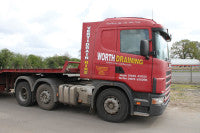 This equipment is transported using two seventeen tonne articulated lorry/trailer combos, which are inspected and serviced every six weeks. "One of the biggest costs for contractors these days is haulage and fuel costs," explains Paul. "Rising fuel costs have put a strain on all businesses involved in transport. At the end of the day we have to pass these increases on to the customers but, in the present economic climate, when securing work is becoming harder, as there is far more competition from other contractors, that is not as easy as it sounds. Also, many clubs and courses are now buying their own machines, which also has an impact on our business."
This equipment is transported using two seventeen tonne articulated lorry/trailer combos, which are inspected and serviced every six weeks. "One of the biggest costs for contractors these days is haulage and fuel costs," explains Paul. "Rising fuel costs have put a strain on all businesses involved in transport. At the end of the day we have to pass these increases on to the customers but, in the present economic climate, when securing work is becoming harder, as there is far more competition from other contractors, that is not as easy as it sounds. Also, many clubs and courses are now buying their own machines, which also has an impact on our business."
"One of the ways to reduce costs is to limit the amount of travelling being done. However, there is only so much work in a given area so, to remain in this line of business, we have to be flexible and be prepared to work anywhere."
"Our guys usually stay on site until they have finished, at which point they load up and move on to the next job. The work is planned so that, on the way to the next site, they can call back at the yard to get the equipment serviced and tines changed, so they are ready to go again." 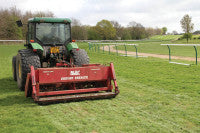
"In our line of business, tines do not last long and, bearing in mind a 25mm diameter tine costs around £18, with forty tines you are looking at a bill of £600 plus per refit, per machine. It is, therefore, important that they keep breakdowns to a minimum, and all the staff have developed good mechanical skills and can cope with most situations."
"Keeping yourself competitive is becoming harder for most contractors - it really is a case of ensuring we deliver when given the opportunity," says Paul. "However, it's a delicate balancing act, as taking on too much work can be detrimental to the business as well; the last thing we want to do is let our customers down."
"The weather is also a huge factor in the success, or otherwise, of our schedule. But, in my twenty-four years, I've seen it all - drought, floods, the lot! Nothing is new, although this year's early drought conditions have been challenging."
